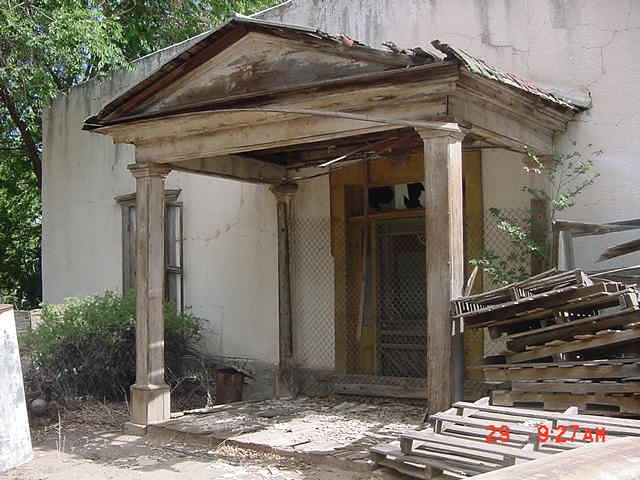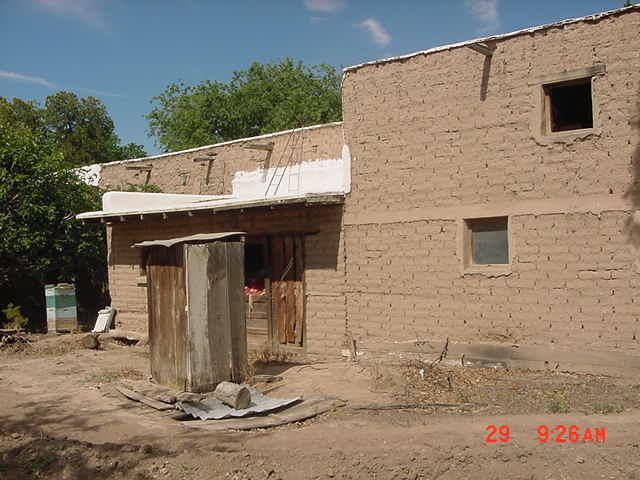In 1850, the Mesilla Civil Colony Land Grant was established by the Mexican government to give settlers in Mesilla land ownership. The grant was later honored by the United States Government. The Civil Colony Land Grant was established to govern the entire town and to distribute the common lands. Father Ramon Ortiz was the Commissioner of Lands in 1851 and in 1853, Guadalupe Miranda filled the office. The Civil Colony Grant Board does not exist today. The Town of Mesilla was incorporated in 1861. In 1882, the year after the railroad was constructed, Mesilla lost its position as the county seat, which it had held since 1855. The county seat was transferred to Las Cruces. In 1958, Mesilla became re-incorporated and became governed by a mayor and Board of Trustees.
The wrangle of politics caused a situation unlike any other known, for the residents of La Mesilla took their politics as seriously as Texas regarded cattle and the branding iron. The fight between the Republicans and the Democrats was called “battle of the bands.” It began in August, 1861 and spread with astounding rapidity. Citizens were thrown into confusion. Many, panic stricken with the sudden outbreak, took up arms, or ran in every direction seeking safety for their families.
The Republicans gathered at the house of Johnny Lemon; the Democrats met in the Plaza where they listened to Padre Gallego and other loyal Democrats warn them of the fearful fiends that would ravage and devastate the village.
General Gregg arrived with a full detachment of armed soldiers from Fort McRae after Washington had been informed of impending trouble between the two factions. They camped in those lands cut by erosion into odd shaped hills with a few level places near the prairie lands for several days. The temperature was hot enough to melt ball bearings. Perhaps their presence avoided trouble. In any case, when it became evident that matters would be settled without gunplay, the General took his troops and galloped back to Fort McRae.
No sooner had the troops disappeared over the horizon than danger hung over La Mesilla like a vast funeral pall. The Democrats decided to antagonize their inhospitable neighbors by marching their band around the Plaza singing a song they knew would irritate the Republicans. The words were sung to the tune of Marching Though Georgia.
The Republicans retaliated by lining up their own band, led by Antonio Garcia playing heartily on his “flica” horn. They marched around the Plaza in one direction while the Democrats marched in the opposing direction, playing and singing just a loudly as their enemies. When they met at the end of the Plaza, the result was as volatile as a lighted match thrown into a can of gasoline.
It started with shouts of insults and curses and eventually erupted into flashes of sabers and revolvers. Before the sun set over this new and growing town, ten men lay dead in the streets, their wives and children rendered homeless without a bread winner. The dusty street in front of Grigg’s store was strewn with forty bleeding, wounded men. One individual lost his eyesight during the skirmish. Another had to have a leg amputated when gangrene set in and threatened his life.
Thinking fast, Old Man Griggs sent one of his clerks galloping hell-bent-for-leather on his fine Kentucky gelding, to overtake General Gregg and his regimental horsebackers. The general and his troops galloped the hard-packed soil back to La Mesilla with breakneck speed, but the damage had already been done.
A detachment of troops was left in town to discourage any further outbreak and the town quieted down. The dead were buried. Families rendered destitute depended on the charity of their neighbors. Both republicans and Democrats suffered; none escaped without experiencing a loss of some kind.
La Mesilla was in the third judicial district and no judge was appointed to the bench at this time; so no one on either side was ever tried for murder.
Among La Mesilla’s eminent visitors was Lew Wallace, whose greatest fame actually came from his novel, Ben Hur, which he wrote while governor of the Territory of New Mexico. Another was Kit Carson, famous Indian Scout and guide. Carson was a familiar sight on the dusty streets of La Mesilla where he carved his name on a tree that was carelessly cut down by a thoughtless resident and used for firewood. It is said that Carson ate regularly in the old La Posta Inn, a thick-walled fortress against rampaging Indians.
The house was built in the early 1800’s and is now used as a storage area for honey which is produced near the house.
Reference:
Political History of Mesilla New Mexico. http://www.oldmesilla.org/html/political_history.html

